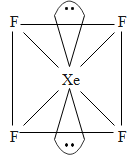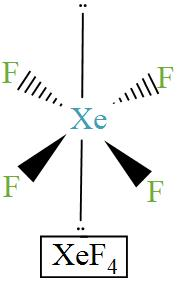
The structure of
A) Planar
B) Tetrahedral
C) Square Planar
D) Pyramidal
Answer
438.6k+ views
Hint: To solve the given question, we first need to know the hybridization of xenon tetrafluoride or
Complete step by step answer:
The central atom in Xe has 4 bond pairs of electrons and two lone pairs of electrons. It undergoes
The hybridization of

The two lone pairs that are present on the opposite corners of an octahedron. This is because of the fact that it will minimize the repulsion between them.
Here is the diagram of the structure of

Hence, the correct answer is Option C.
Note: We can define hybridization as the idea of atomic orbitals to choose from newly hybridized orbitals. This, in turn, influences the molecular geometry and bonding properties of a molecule. Hybridization also defines the expansion of valence bond theory and this concept illustrates various compounds with
Complete step by step answer:
The central atom in Xe has 4 bond pairs of electrons and two lone pairs of electrons. It undergoes
The hybridization of

The two lone pairs that are present on the opposite corners of an octahedron. This is because of the fact that it will minimize the repulsion between them.
Here is the diagram of the structure of

Hence, the correct answer is Option C.
Note: We can define hybridization as the idea of atomic orbitals to choose from newly hybridized orbitals. This, in turn, influences the molecular geometry and bonding properties of a molecule. Hybridization also defines the expansion of valence bond theory and this concept illustrates various compounds with
Recently Updated Pages
Master Class 4 Maths: Engaging Questions & Answers for Success

Master Class 4 English: Engaging Questions & Answers for Success

Master Class 4 Science: Engaging Questions & Answers for Success

Class 4 Question and Answer - Your Ultimate Solutions Guide

Master Class 11 Economics: Engaging Questions & Answers for Success

Master Class 11 Business Studies: Engaging Questions & Answers for Success

Trending doubts
Give 10 examples of unisexual and bisexual flowers

Draw a labelled sketch of the human eye class 12 physics CBSE

a Tabulate the differences in the characteristics of class 12 chemistry CBSE

Differentiate between homogeneous and heterogeneous class 12 chemistry CBSE

Why is the cell called the structural and functional class 12 biology CBSE

Differentiate between insitu conservation and exsitu class 12 biology CBSE




